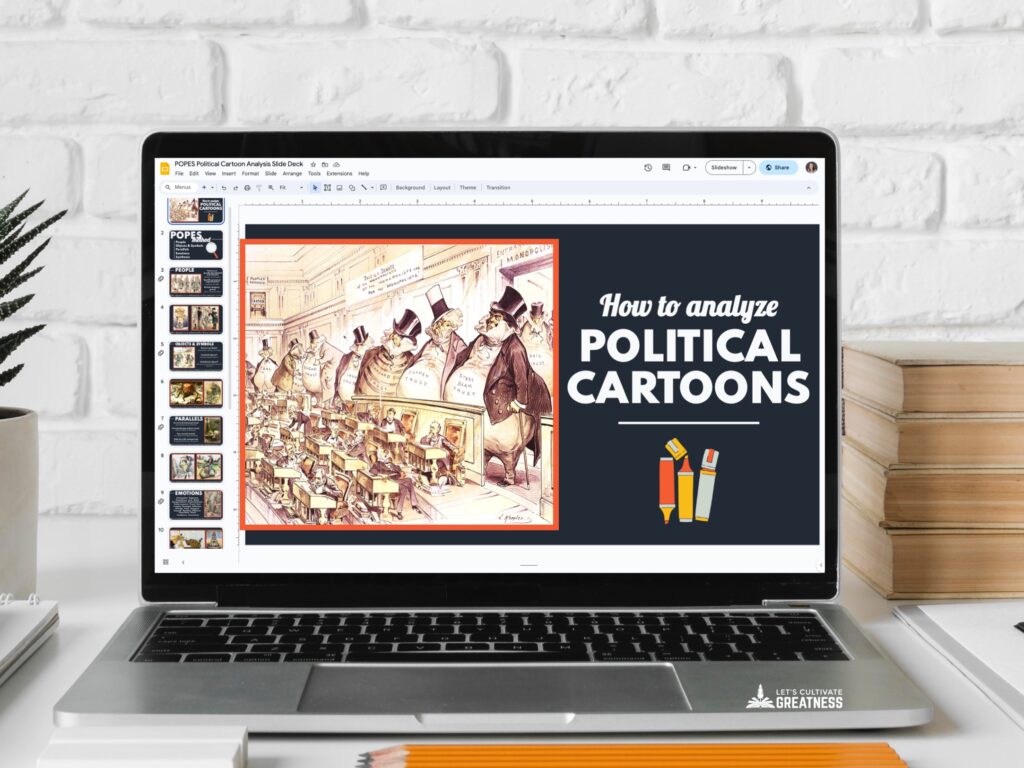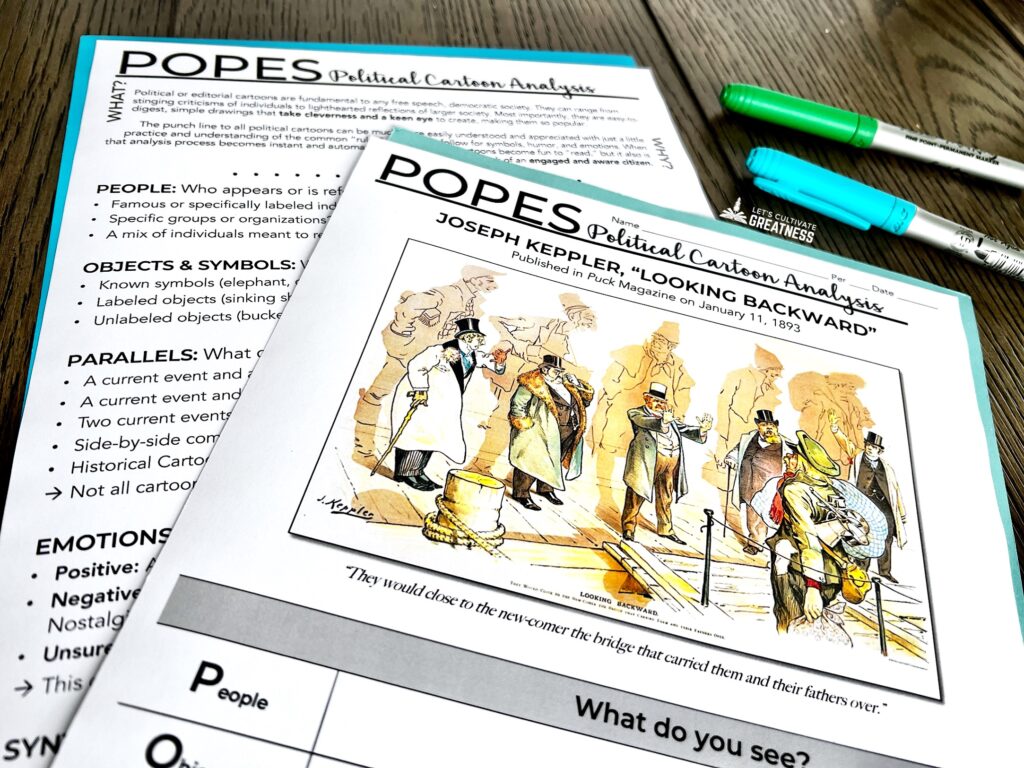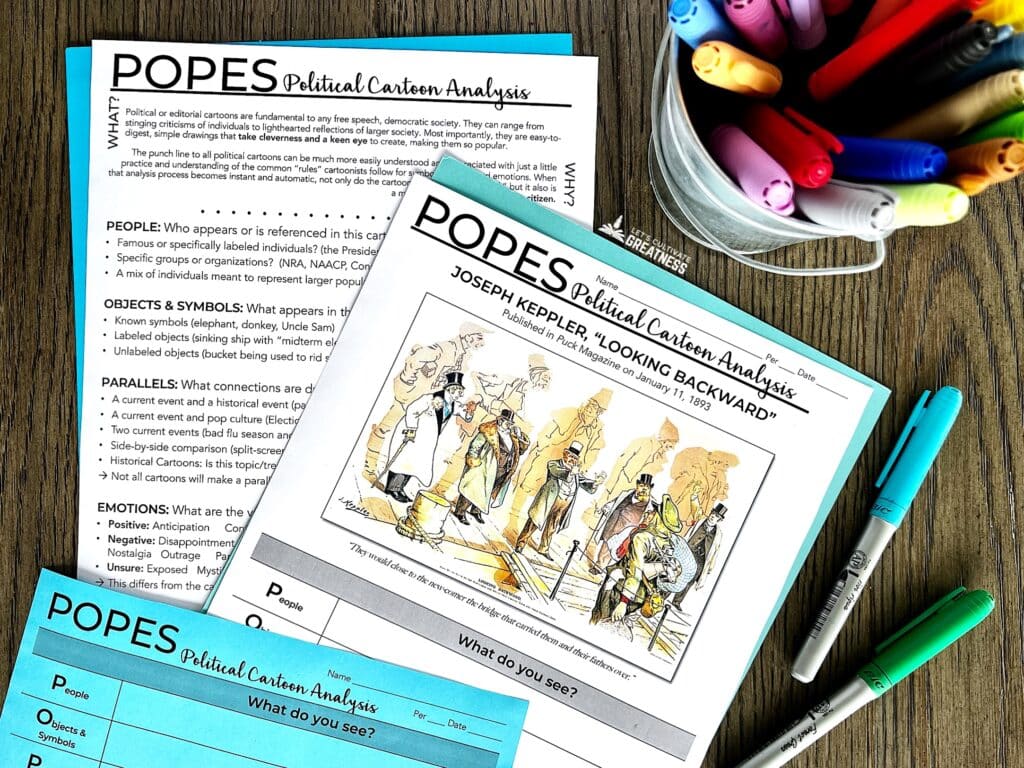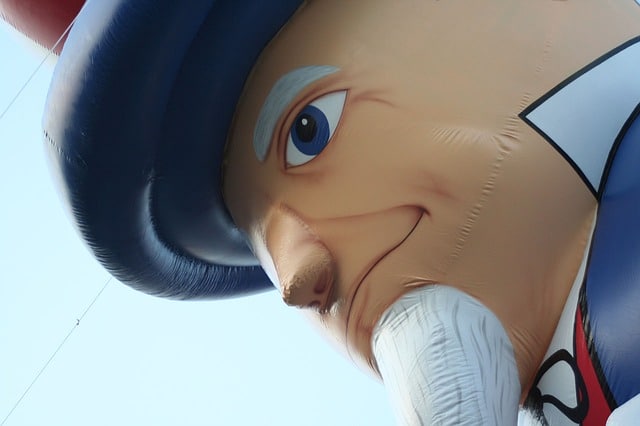Political cartoons are a must if you’re teaching Civics, but also for any US History or Current Issues class.
They are accessible to lower-level readers and ELL students yet still challenge higher-level thinking. They also let you build your students’ schema of the world with the nuggets of outside information they reference.
And all in about 5 to 10 minutes.
Since I love using cartoons across all my social studies classes, I’ve developed this POPES strategy to help students easily analyze and synthesize any cartoon—current or historical.
The easiest way to use political cartoons in a Civics or Current Issues class is as bell ringers, so this blog post is written assuming that.
Check out this blog post on Lesson Ideas for Using Political Cartoons in Civics for more ways to incorporate cartoons into your actual government lessons.
Everything mentioned in this blog post is available in a FREE done-for-you Analyzing Political Cartoons kit, including a slide deck and student worksheets.
But before diving into the process, let’s set any political cartoon lesson up for success by using these teaching strategies.

Pick Compelling Political Cartoons
Not every cartoon qualifies. Pick cartoons referencing topics at least some of your students will know. Some may need you to provide more background context than others, but don’t pick ones with no access point for your students.
Especially if you are doing political cartoons as bell ringers, vary the obscurity of topics at the center of the cartoon. This balances students’ exposure to new information with being able to readily analyze content they already know.
For current cartoons, only select them a week or two in advance. The point is that the cartoons are of “today’s” news.
Obviously, if you’re doing historical cartoons in your US history class, that doesn’t apply!
Here are my go-to spots for selecting current and historical cartoons:
Daryl Cagle’s searchable database of current cartoons
The Week’s and US News’s collections
Library of Congress’s collection of over 800 cartoons from throughout American history and their dedicated Herbert Block collection that spans much of the late 1900s
Wikimedia Commons’ collection of Puck and Judge magazine covers from the late 1800s and early 1900s
Teach How to Analyze
Before diving into analyzing cartoons, set time aside to teach the process!
Select some easy practice cartoons that highlight each component well in isolation. This usually takes most of a class period at the beginning of the year.
For fun, this is when I sneak in one or two that happen to actually include the Pope!
Predict their Questions
With each cartoon you select, spend a few seconds thinking about what background context students will need or if they might have any misconceptions.
It may be just a quick fact-check about the topic. For example, a cartoon about the President’s low approval rating means I look up the current Gallup Poll numbers to share.
In these questions, I find cartoons to be the most rewarding gateway to sharing all sorts of information core to being an informed citizen that may otherwise never come up in class. Like that, there are weekly polls that track approval ratings.
Open with Think Time
Always allow a few minutes of process time for students to soak in a new cartoon. Some may laugh immediately, others may need some table talk time to identify all the elements.
Setting the clock for two minutes before asking students to share gives everyone the chance to participate.
Let Them do the Analyzing
Ask if any students can provide some background context of what the cartoon is depicting, filling in details as necessary.
After that, step back and let students work through the POPES process. Ask them what they see for the four elements and let them form their concluding synthesis sentence.

Now, let’s finally dive into the POPES political cartoon analysis method! Here are the basics for how it works:
People
Who is in the cartoon? Specific individuals? Organizations or groups?
Objects & Symbols
What appears in this cartoon? What do they represent?
Parallels
What connections are being drawn between two unrelated events?
Emotions
What are the various people or symbols feeling?
Synthesis
How can all these pieces be put together in a concise sentence to convey the cartoonist’s message?

Grab your own copy of these done-for-you student sheets and how-to slide deck in my FREE Political Cartoons Analysis Kit. I can’t recommend this strategy enough for exploring political cartoons with students!
Feature image photo credit: Pixabay





